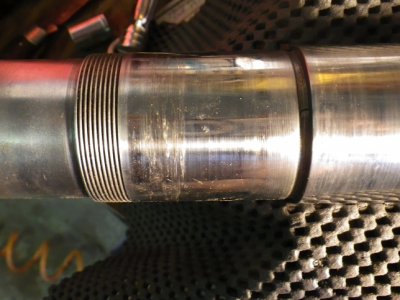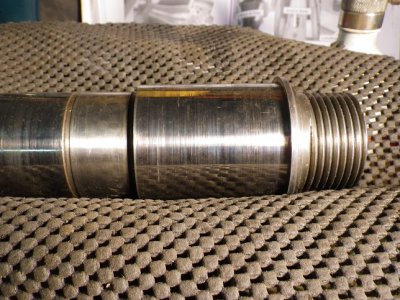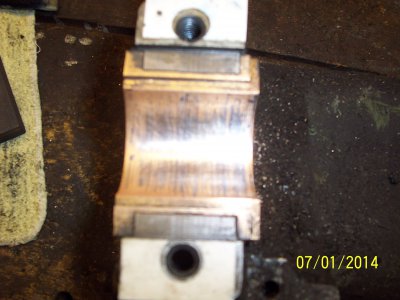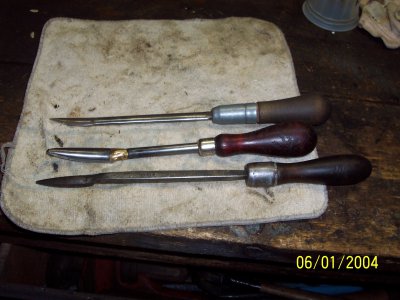-
Welcome back Guest! Did you know you can mentor other members here at H-M? If not, please check out our Relaunch of Hobby Machinist Mentoring Program!
You are using an out of date browser. It may not display this or other websites correctly.
You should upgrade or use an alternative browser.
You should upgrade or use an alternative browser.
Tore Down The Head Stock On My 10l How Do These Bearings Look?
- Thread starter catskinner
- Start date
- Joined
- Dec 7, 2011
- Messages
- 61
Hi Catskinner, From your pictures, your lathe spindle bearings look as if they are an integral part of the headstock casting (as opposed to loose removable shell bearings) and they also look as if they are cast iron. As you have already indicated that you do not know what a spoon scraper is, you are advised to steer clear of scraping the bearing with a spoon scraper, as you may end up doing more harm than just leaving it as it is. It worked for many years as is, so don't kick the sleeping dog! Regarding the shims, you need to make sure that the same shims are put back into their respective positions, as these are used to get clearance on the bearings.
My advice to you would be to clean everything up by polishing using Scotchbrite or steel wool and leave the scratches for now. Once everything has been cleaned up, spread some engineers blue onto the spindle bearing surfaces and put the spindle into the headstock casting bearing pockets as it would be on the lathe. Don't put the bearing caps on just yet. With gravity holding the shaft in place, rotate the shaft by 360 degrees and remove the spindle and observe the contact of the spindle to the bearing surfaces. This will indicate to you if there are any high spots that may be holding the spindle bearing higher, thereby preventing the spindle from bedding properly in the bearing journal pockets.
A 60 to 70 % contact pattern on the lower segment of the bearing journal is what would be considered good. If this is not the case, you are advised to find someone with the experience of scraping bearings to assist you further.
Having done that and assuming that there are no high spots on the bearing journals that may need scraping to remove, again put some engineers marking blue onto the spindle bearing surfaces and put the spindle back into the headstock, put the shims in place and put the bearing caps on and bolt them down and tighten them. Rotate the shaft by 360 degrees and open everything up again. Note that a tight shaft at this point indicates to you that the bearing is too tight and something is squeezing the shaft and causing it to be tight. Observe the contact pattern on the headstock bearing journal surfaces again. This will indicate to you any high spots, which will cause binding of the spindle.
Next, clean off the engineers marking blue and re-assemble using oil this time. After everything has been tightened down again, set up a dial test indicator to measure the clearance of each bearing in the vertical plane using a tommy bar or large screwdriver to lift the spindle. (i.e.: up and down direction.) As a rule of thumb, one thousands of an inch per one inch diameter of spindle is an acceptable clearance. Any clearance smaller than this will cause the bearing to run hot and may even cause overheating and possible seizure. This is where you may have to remove or insert shims to adjust the bearing clearance to the desired value, in your case around two thousandths of an inch.
Please remember that the oil in a bearing of this nature will float the shaft as it starts turning, using wedge lubrication and this is why a clearance is required. The oil will go to the area of the bearing periphery where the pressure is the greatest and will lift the spindle off the bearing journal, thereby preventing the metal surfaces from rubbing together. The same principal applies to your car crankshaft and bearings, the only difference being that your car bearings are force fed oil and will thereby withstand a much higher loading than the bearings on your lathe, which are only gravity fed from an oil bath or oil dripper.
Any scraping of the headstock bearing journals will have an affect on the accuracy of the lathe overall. Scraping too much off the bottom part of the lower pockets will cause the centreline of the lathe to lower below that of the tailstock centre. Any uneven scraping on the sides of the bearing will cause the centreline to shoot out and an angle to that of the lathe bed, so you are best advised not to scrape too much off the bearing journals.
An old timer machinist in his 80's said to me that the best line shaft bearings were the cast iron bearings, so don't down rate your lathe bearings as been inferior in any way. These cast iron bearings have been working well in industry for more than 200 years in all kind of machines.
It would be nice if you post pictures of the steps that I have described above, when you get to that stage of the overhauling game, so that others can see and learn from your work and assist you further, as well.
Geoffrey.
My advice to you would be to clean everything up by polishing using Scotchbrite or steel wool and leave the scratches for now. Once everything has been cleaned up, spread some engineers blue onto the spindle bearing surfaces and put the spindle into the headstock casting bearing pockets as it would be on the lathe. Don't put the bearing caps on just yet. With gravity holding the shaft in place, rotate the shaft by 360 degrees and remove the spindle and observe the contact of the spindle to the bearing surfaces. This will indicate to you if there are any high spots that may be holding the spindle bearing higher, thereby preventing the spindle from bedding properly in the bearing journal pockets.
A 60 to 70 % contact pattern on the lower segment of the bearing journal is what would be considered good. If this is not the case, you are advised to find someone with the experience of scraping bearings to assist you further.
Having done that and assuming that there are no high spots on the bearing journals that may need scraping to remove, again put some engineers marking blue onto the spindle bearing surfaces and put the spindle back into the headstock, put the shims in place and put the bearing caps on and bolt them down and tighten them. Rotate the shaft by 360 degrees and open everything up again. Note that a tight shaft at this point indicates to you that the bearing is too tight and something is squeezing the shaft and causing it to be tight. Observe the contact pattern on the headstock bearing journal surfaces again. This will indicate to you any high spots, which will cause binding of the spindle.
Next, clean off the engineers marking blue and re-assemble using oil this time. After everything has been tightened down again, set up a dial test indicator to measure the clearance of each bearing in the vertical plane using a tommy bar or large screwdriver to lift the spindle. (i.e.: up and down direction.) As a rule of thumb, one thousands of an inch per one inch diameter of spindle is an acceptable clearance. Any clearance smaller than this will cause the bearing to run hot and may even cause overheating and possible seizure. This is where you may have to remove or insert shims to adjust the bearing clearance to the desired value, in your case around two thousandths of an inch.
Please remember that the oil in a bearing of this nature will float the shaft as it starts turning, using wedge lubrication and this is why a clearance is required. The oil will go to the area of the bearing periphery where the pressure is the greatest and will lift the spindle off the bearing journal, thereby preventing the metal surfaces from rubbing together. The same principal applies to your car crankshaft and bearings, the only difference being that your car bearings are force fed oil and will thereby withstand a much higher loading than the bearings on your lathe, which are only gravity fed from an oil bath or oil dripper.
Any scraping of the headstock bearing journals will have an affect on the accuracy of the lathe overall. Scraping too much off the bottom part of the lower pockets will cause the centreline of the lathe to lower below that of the tailstock centre. Any uneven scraping on the sides of the bearing will cause the centreline to shoot out and an angle to that of the lathe bed, so you are best advised not to scrape too much off the bearing journals.
An old timer machinist in his 80's said to me that the best line shaft bearings were the cast iron bearings, so don't down rate your lathe bearings as been inferior in any way. These cast iron bearings have been working well in industry for more than 200 years in all kind of machines.
It would be nice if you post pictures of the steps that I have described above, when you get to that stage of the overhauling game, so that others can see and learn from your work and assist you further, as well.
Geoffrey.
- Joined
- Mar 3, 2015
- Messages
- 171
From your pictures, your lathe spindle bearings look as if they are an integral part of the headstock casting (as opposed to loose removable shell bearings) and they also look as if they are cast iron.[/QUOTE
Yes they are cast as part of the headstock. I was wondering if the spindle had been changed before as it looks really nice compared to the bearings. Here are some pictures of the spindle.


- Joined
- Mar 3, 2015
- Messages
- 171
Thanks guys for the info this is all starting to make sense now.
I think your bearings look fine. The scoring is not significant to be an issue in my opinion. Scraping oil pockets is, not required, that is what the linear scoring is there for. Clean it up, put new wicks in, lube it up and adjust the bearings per the South Bend instructions.
Vlad
Vlad
- Joined
- Mar 3, 2015
- Messages
- 171
Thanks again guys I will do as suggested, sounds like it will work out fine.
- Joined
- Feb 8, 2014
- Messages
- 494
Hi Catskinner, From your pictures, your lathe spindle bearings look as if they are an integral part of the headstock casting (as opposed to loose removable shell bearings) and they also look as if they are cast iron. As you have already indicated that you do not know what a spoon scraper is, you are advised to steer clear of scraping the bearing with a spoon scraper, as you may end up doing more harm than just leaving it as it is. It worked for many years as is, so don't kick the sleeping dog! Regarding the shims, you need to make sure that the same shims are put back into their respective positions, as these are used to get clearance on the bearings.
My advice to you would be to clean everything up by polishing using Scotchbrite or steel wool and leave the scratches for now. Once everything has been cleaned up, spread some engineers blue onto the spindle bearing surfaces and put the spindle into the headstock casting bearing pockets as it would be on the lathe. Don't put the bearing caps on just yet. With gravity holding the shaft in place, rotate the shaft by 360 degrees and remove the spindle and observe the contact of the spindle to the bearing surfaces. This will indicate to you if there are any high spots that may be holding the spindle bearing higher, thereby preventing the spindle from bedding properly in the bearing journal pockets.
A 60 to 70 % contact pattern on the lower segment of the bearing journal is what would be considered good. If this is not the case, you are advised to find someone with the experience of scraping bearings to assist you further.
Having done that and assuming that there are no high spots on the bearing journals that may need scraping to remove, again put some engineers marking blue onto the spindle bearing surfaces and put the spindle back into the headstock, put the shims in place and put the bearing caps on and bolt them down and tighten them. Rotate the shaft by 360 degrees and open everything up again. Note that a tight shaft at this point indicates to you that the bearing is too tight and something is squeezing the shaft and causing it to be tight. Observe the contact pattern on the headstock bearing journal surfaces again. This will indicate to you any high spots, which will cause binding of the spindle.
Next, clean off the engineers marking blue and re-assemble using oil this time. After everything has been tightened down again, set up a dial test indicator to measure the clearance of each bearing in the vertical plane using a tommy bar or large screwdriver to lift the spindle. (i.e.: up and down direction.) As a rule of thumb, one thousands of an inch per one inch diameter of spindle is an acceptable clearance. Any clearance smaller than this will cause the bearing to run hot and may even cause overheating and possible seizure. This is where you may have to remove or insert shims to adjust the bearing clearance to the desired value, in your case around two thousandths of an inch.
Please remember that the oil in a bearing of this nature will float the shaft as it starts turning, using wedge lubrication and this is why a clearance is required. The oil will go to the area of the bearing periphery where the pressure is the greatest and will lift the spindle off the bearing journal, thereby preventing the metal surfaces from rubbing together. The same principal applies to your car crankshaft and bearings, the only difference being that your car bearings are force fed oil and will thereby withstand a much higher loading than the bearings on your lathe, which are only gravity fed from an oil bath or oil dripper.
Any scraping of the headstock bearing journals will have an affect on the accuracy of the lathe overall. Scraping too much off the bottom part of the lower pockets will cause the centreline of the lathe to lower below that of the tailstock centre. Any uneven scraping on the sides of the bearing will cause the centreline to shoot out and an angle to that of the lathe bed, so you are best advised not to scrape too much off the bearing journals.
An old timer machinist in his 80's said to me that the best line shaft bearings were the cast iron bearings, so don't down rate your lathe bearings as been inferior in any way. These cast iron bearings have been working well in industry for more than 200 years in all kind of machines.
It would be nice if you post pictures of the steps that I have described above, when you get to that stage of the overhauling game, so that others can see and learn from your work and assist you further, as well.
Geoffrey.
VERY WELL SAID. I totally agree
fixit
- Joined
- Mar 3, 2015
- Messages
- 171
blVERY WELL SAID. I totally agree
fixit
Thank you fixit, my plan is to do just that. The parts are in the electrolysis tank now and will be pulled out about noon. A little paint and the reassembly starts.



